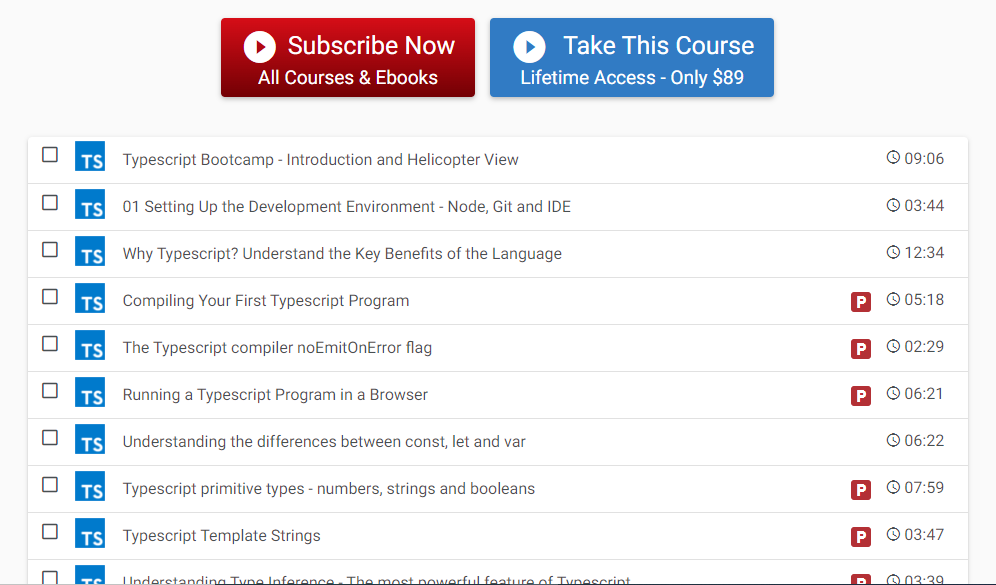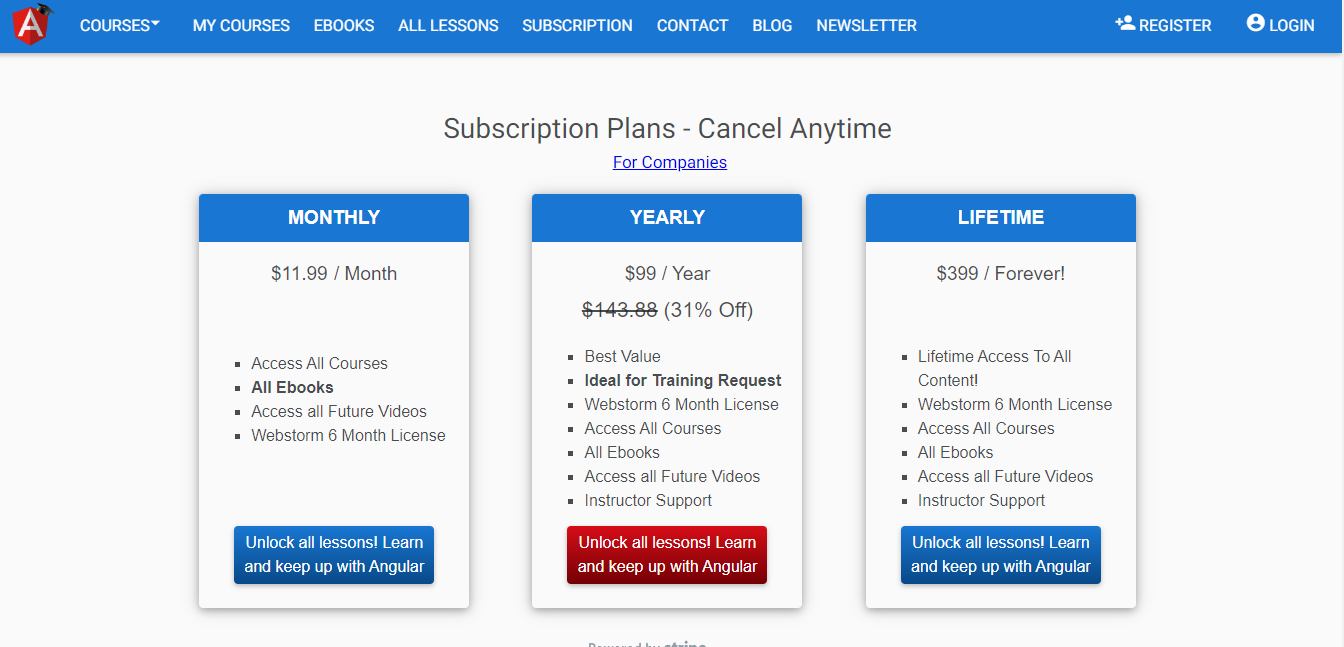Should I Sell Online Courses With a Membership?
 Platform Review
Platform Review

Learn why a membership model is one of the best ways of selling courses, and what are the specific tactics that I have been using over the years.
Are you considering selling your online courses using a membership model or a one-time payment model?
Membership and one-time payment models are two of the most common pricing models in the course creation industry.
Having a clear direction about which of these models is the best fit for your business right from the start is crucial.
This will not only determine and fast-track your success, but it will also save you a lot of stress and reduce your mistakes.
I've been creating online courses since 2016, and this single decision helped me generate well over $1.6 million in total revenue.
In this article, I'll share my strategy for doing so, as well as what to consider before choosing a pricing model and the pros and cons of using a membership model vs. a one-time payment model to sell online courses.
You can ultimately make the best decision for your online course business if you consider all of these factors and follow my strategy.
But first, to answer the question.
Should you sell online courses with a membership?
Whether or not you should sell online courses with a membership depends on a number of factors, including your target audience, the type of course you're offering, price, access and availability, and your goals as a business or individual.
I'll go over each of these factors in detail.
Remember it's essential to get this decision right from the start. So make sure to read every single piece of detail all the way through.
Related: Online Courses vs. Membership Sites: Which Is Best For You?
You can also check out all the free guides at the Course Creator Academy by clicking on the Academy link on the top menu bar.
If you are looking to learn how to sell online courses, here is my most detailed guide on it. In it, I talk in detail about all the strategies that have worked for me:
How to Sell Online Courses? The Ultimate Guide
Without further ado, let's cut to the chase!
What To Consider Before Choosing a Membership or One-time Payment Model?
Before deciding on a membership or one-time payment model for selling online courses, there are a few factors to consider.
Type Of Content
First, think about the type of content you are offering and how it will be delivered.
For instance, if you have a large amount of content that will be delivered regularly and requires ongoing support or updates, a membership or subscription-based model may be a great fit.
Customers would be able to access all of your content for a monthly or annual fee in this case.
On the other hand, a one-time payment model can be a great option if you're offering a self-contained course that doesn't require ongoing support or updates.
Access and Availability
Consider how members will access your courses, and how frequently they will have access to new content. Will they be able to access all courses at once, or will they have to wait for new ones to be released?
Ideally, a membership model should provide instant access to the entire course catalog, but you don't have to create the entire course catalog before launching a membership. You can make them as you go and then update your catalog when a new course is ready.
When I first started in 2016, this was exactly the strategy I used to combine both business models.
I created a few courses and set up a site with a membership. I then added a "coming soon" section with the courses I planned to record the following year, with only the title and thumbnail of the courses, so people would know what they would be getting with the membership.
After that, I began to record the remaining courses one by one, and it took me two years to complete the catalog.
But, despite the fact that I didn't have a full catalog of courses at the start, my course revenue from one-time payments and memberships grew and converted well because people knew what to expect from me soon.
Pricing
Another thing you want to consider is the price of your courses.
If you have a lot of high-quality content, you might be able to charge a higher price for a membership.
A pay-per-course model, on the other hand, may be a better fit if you have a smaller amount of content or your courses are not as in-depth.
This would allow customers to purchase only the courses they are interested in, without committing to a long-term subscription.
The Target Audience
Who is your target audience for the online course?
Understanding the needs and preferences of your potential customers will help you choose a membership model that aligns with their expectations and provides value to them.
For example, if the courses are aimed at beginners, a shorter, lower-cost membership model may be more appropriate.
Additionally, you should consider the customer experience and how easy it will be for them to access your courses.
Will you offer ongoing support and engagement through forums or other means?
A well-designed membership platform with clear navigation and a user-friendly interface can make a big difference in terms of customer satisfaction.
Your Business Goals
What are your goals for the online course business?
Consider how the membership model you choose will help you achieve these goals.
For example, if your goal is to generate a consistent stream of revenue, a subscription-based model may be a good fit. But if your goal is to generate a large amount of revenue upfront, a one-time payment model may be better.
Now, Let's look at the Pros and Cons of each model.
Pros Of Selling Online Courses With a Membership Model
There are several potential benefits to selling online courses using a membership model. These include:
Recurring Revenue
A membership model allows you to generate recurring revenue from your students by charging them a monthly subscription fee to access your course content. This can provide a more stable and predictable income stream for your business compared to selling one-off courses.
Greater Engagement
With a membership model, you can encourage greater engagement from your students by providing regular updates and new content. This can help to keep your students motivated and invested in the course, which can lead to better outcomes and higher satisfaction.
Improved Customer Retention
You can improve customer retention and reduce churn by providing ongoing support and new content. This is especially useful if you have a high-priced course, as the cost of acquiring a new customer can be substantial.
Enhanced Credibility
By offering a membership program, you can demonstrate your expertise and commitment to your students. This can help to build credibility and trust, both of which are important factors in attracting and retaining customers.
Potential For Upselling
A membership model can also provide opportunities for upselling and cross-selling additional products or services to your students. For example, you might offer premium services or additional courses to your members at a discounted rate.
Flexibility
A membership model allows you to offer different pricing tiers or levels of access to your courses such as monthly, annual, or lifetime subscriptions. This can be useful for targeting different types of customers with different needs and budgets.
For example, I see courses on my website in two ways
Notice this:

You can choose to buy just one course for $89 as a one-time payment. But if instead, you want to gain access to all the courses on the website, then you can subscribe using the red button.
And you get taken to this page

So you see, a membership allows you to offer your courses on a flexible schedule, which can be convenient for both you and your students.
Greater Value For Students
A membership model allows you to offer a greater variety of content and resources to your students, which can make your course more valuable to them and encourage them to continue their membership.
Cons Of Selling Online Courses With a Membership Model
There are a few potential drawbacks to selling online courses using a membership model.
Ongoing Commitment
Students who enroll in a membership model are typically committing to a longer-term relationship with your course or learning platform, which means you must consistently produce new and relevant content to keep them engaged.
This can be a disadvantage if you're not able to consistently provide high-quality content or support to your students.
Cancellation Risk
If you're relying on a membership model for revenue, you may be at risk of losing students. Some of them may decide to cancel their membership after a short period, which can lead to high churn rates.
This can be particularly problematic if you have a large number of customers who are canceling their memberships, as it can impact your overall revenue.
It Can be Challenging To Monetize Your Content:
If you are offering a large amount of content for a fixed monthly or annual fee, it can be difficult to accurately price your courses and ensure that you are making a profit.
Difficult To Scale
It can be difficult to scale a membership-based business, as you need to continually add new members to maintain your revenue. This requires ongoing marketing efforts and the development of new content to keep current members engaged.
Higher Upfront Work and Investment
Setting up and maintaining a membership platform necessitates a significant amount of upfront work and investment, including the creation of course content as well as the implementation of payment and access systems.
This can be a barrier for course creators who do not have the necessary resources or expertise.
Pros Of Selling Online Courses With a One-time Payment Model
When it comes to selling online courses using a one-time payment model, there are several potential advantages. These include:
Higher Potential Revenue
With a one-time payment model, you have the opportunity to make a larger sale upfront and revenue which can then be used to create new courses as needed, rather than being tied to a recurring payment schedule.
Simplicity
A one-time payment model is generally easier to set up and manage than a membership-based course, as you don't have to worry about recurring billing or tracking access to content.
Easy To Upsell
If you offer a one-time payment course, it may be easier to sell additional products or services to your customers, as they have already made a purchase and may be more likely to trust your expertise.
Customer Control
Customers who purchase a one-time payment course have more control over their learning experience, as they can go through the course at their own pace and revisit the material as needed.
No Customer Churn
With a one-time payment model, you don't have to worry about customer churn, as customers are not committing to ongoing payments. This can help you to focus on creating high-quality content and marketing your course to new customers.
Greater Control Over Pricing
Also, with a one-time payment model, you have more control over the price of your course because you can set the price at a level that reflects the value of the course.
Cons Of Selling Online Courses With a One-time Payment Model
Likewise, there are a few potential downsides to selling online courses using a one-time payment model.
Limited Income Potential
A one-time payment model allows you to earn money from a course only once, whereas a subscription model allows you to earn money on an ongoing basis. This can make it more difficult to sustain a business selling online courses with a one-time payment model.
More Difficult To Track Results
It can be harder to track the success of a one-time payment model, as you only have a single point of data to work with.
But with a subscription model, you can track customer engagement and retention over time, which can provide valuable insights into what is working and what needs to be improved.
Lack of Ongoing Engagement
One-time payment models may not provide as much incentive for students to continue engaging with the course material, as they have already paid for the course and may not feel as invested in the learning process.
Decreased Value Perception
Some students may perceive a one-time payment model as offering less value, especially if they are not receiving ongoing support or access to updated course materials that a membership provides.
Increased Competition
One-time payment models may make it easier for students to compare prices and shop around for the best deal, which may increase competition and make it more difficult for you to stand out in the market.
Conclusion: Should You Sell Online Courses With a Membership?
Whether or not you should sell online courses with a membership model or one-time payment model depends on the type of course you're offering, the target audience for your course, and other factors as outlined in this post.
Some people may prefer to purchase online courses on a membership basis because it allows them to access a wide range of content for a single price, whereas others may prefer to pay for individual courses for a variety of reasons.
The fact remains that, both are great ways to earn good income when done correctly.
But in any case, it is always an excellent idea to offer both options.
You can start simple with a one-time payment model to get up and running quickly, and then integrate a membership as you gain more customers.
Remember that you don't have to create the entire course catalog before launching a membership; you can start with a few videos and then update your catalog as you go.
This gives your customers the option of how they want to access your content, and the best part is that they can switch from one to the other, which is an excellent way to incorporate upsells and cross-selling into your business.
Ultimately, the decision to use a membership or one-time pricing model for your online courses will depend on your specific business goals, the preferences of your target audience, and other important factors.
Nevertheless, it's a great idea to do some research and consider your options carefully before making a decision.
Now you understand the benefits and drawbacks of both membership and one-time payment pricing models and how to choose the best one for your online course business.
You'll also need a platform that allows you to offer both options easily and efficiently.
One such platform is OnlineCourseHost.com.
It is the most affordable and beginner-friendly online course hosting platform for selling one-time courses and memberships with essential marketing features to drive new audiences, such as email marketing and Facebook ads integration, to help you grow your online course business faster.
But, more than just a platform, we wanted to provide you with the information you need to grow your online course business successfully.
That is why we created the Course Creator Academy, where you can find everything you need to become a successful online course creator all in one place for free.
To get notified when new content is available here at the Academy, you can subscribe here to our weekly newsletter:
If you are looking to ask any questions on online course creation or want to be a part of a fantastic community of course creators, you can reach me here on my Facebook group:
Join the Course Creator Academy Facebook Group
Ready to learn how to launch your first course on OnlineCourseHost.com? Here are the helpful guides for you to check out:
- Best Online Course Platforms (Ultimate Guide)
- How To Create An Online Course (In 15 Super-Practical Steps)
- How To Choose An Online Course Topic That Sells
- How To Record And Edit Your First Online Course
- Affordable Online Course Equipment - Complete Practical Guide
- How To Hire An Online Course Team
- The Ultimate Online Course Launch Checklist
- How To Create The Perfect Online Course Sales Page
- Create A Powerful Brand For Your Online Courses (In 5 Steps)
- How To Sell Online Courses? The Ultimate Guide
- How To Promote Your Online Course - Complete Guide
I hope you found this post helpful; let me know in the comments below what other topics you would like me to cover or any questions you have.
Thanks for reading… and enjoy the course creation process! 😉
Vasco Cavalheiro
OnlineCourseHost.com Founder & Online Course Creator








 Start Here
Start Here Course Creation Journey Step by Step
Course Creation Journey Step by Step  Course Creation Software Reviews
Course Creation Software Reviews Online Course Marketing
Online Course Marketing Course Creation Tips & Tricks
Course Creation Tips & Tricks Course Equipment
Course Equipment Online Course Marketplaces
Online Course Marketplaces Revenue Reports
Revenue Reports Best Practices
Best Practices Frequently Asked Questions
Frequently Asked Questions Platform Reviews
Platform Reviews